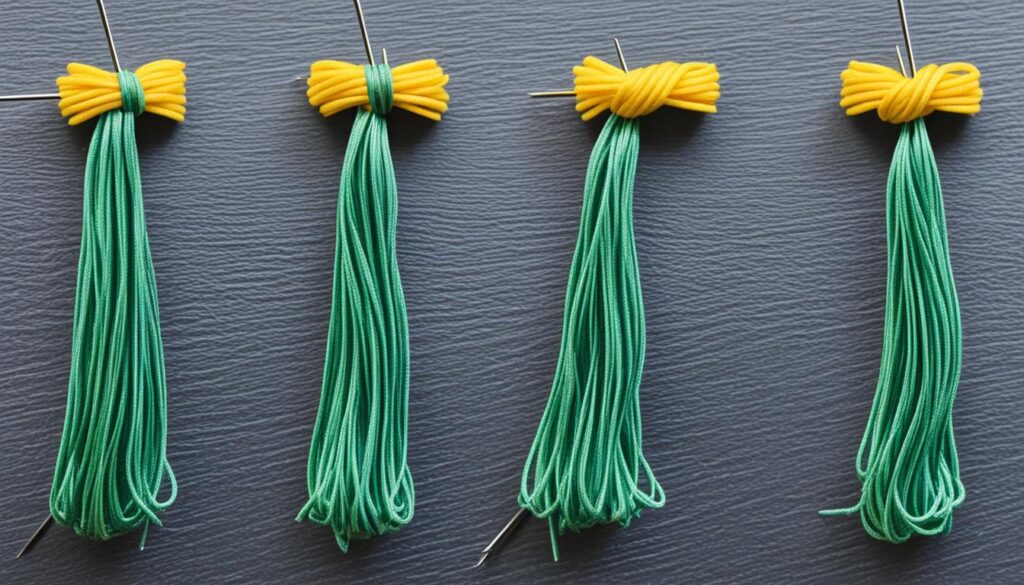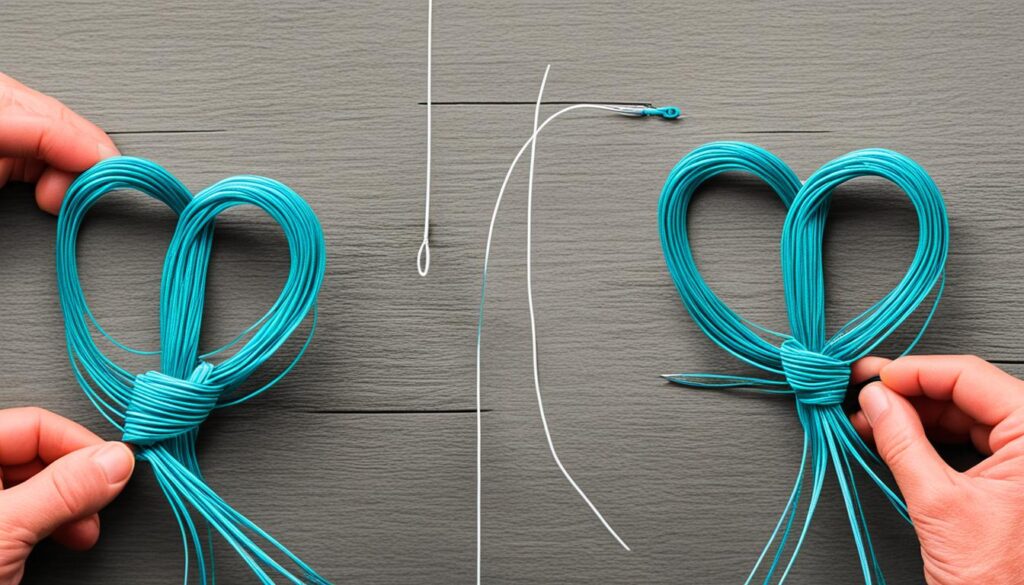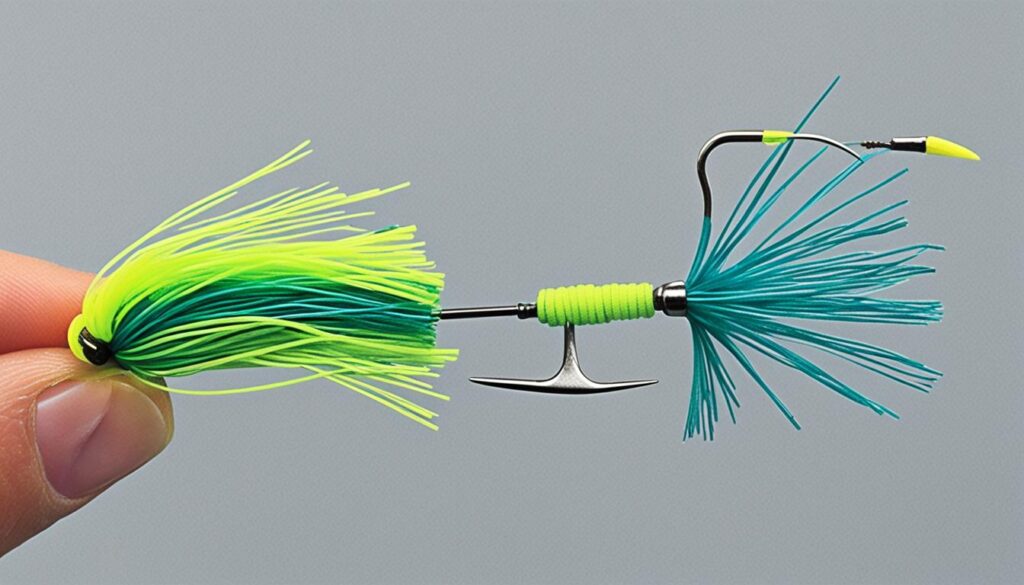Welcome to our Uni Knot guide! We’ll show you how to tie a jig skirt using a Uni Knot. It’s a key fishing knot that every angler should learn. This step-by-step guide is perfect for all anglers, from beginners to experts. You’ll be able to secure your jig skirt without any trouble.
Key Takeaways
- Learn the step-by-step process of tying a Uni Knot for your jig skirt.
- Understand why the Uni Knot is a popular choice for securing jig skirts.
- Discover other fishing knots commonly used in angling.
- Explore the different types of artificial lures and natural baits for successful fishing.
- Embrace good fishing etiquette and outdoor sportsmanship.
The Uni Knot: Step-by-Step Instructions
The Uni Knot is a useful fishing knot, perfect for your jig skirts. Here is a simple guide to tie it:
- Start by doubling the line and passing it through the eye of your lure or jig.
- Make a loop with the doubled line, ensuring the tag end is longer.
- Hold the loop and tag end with your thumb and forefinger.
- Wrap the tag end around the double line. Pass it through the loop. Do this 5 to 6 times.
- Moisten the knot to reduce friction.
- Now, pull both the standing end and tag end to tighten the knot. Keep it steady as you pull.
- Finally, trim the tag end close, leaving a small tag for safety.
It’s good to practice the Uni Knot a few times to get it down. Soon, you’ll tie it fast and secure. Now you can go fishing with confidence!
“The Uni Knot is not only easy to tie, but it is also incredibly reliable. It provides a strong and secure connection for your jig skirt, giving you the confidence to fish with peace of mind.” – Angler’s Pro Tips
Now you can tie the Uni Knot for your jig skirt. Let’s see why anglers love this knot. Next, we’ll look at the benefits of using the Uni Knot and how it helps catch fish.
Why Use the Uni Knot for Jig Skirts
The Uni Knot is perfect for securing jig skirts because it’s strong and reliable. It’s easy to tie and stays tight, even under pressure. Your skirt won’t slip off, whether you’re casting, jigging, or reeling in your catch. This makes it superb for keeping your jig skirt exactly where you want it, making it more likely to catch fish.
The Uni Knot stands out because it works well with different fishing lines. It fits monofilament, fluorocarbon, and braided lines. This versatility is great for both new and experienced anglers.
The Uni Knot is also simple to tie, great for those just starting with fishing knots. A few steps and you’re all set. It’s strong and dependable, meaning you can focus on fishing, not your skirt’s security.
Every little thing counts when you’re fishing. The Uni Knot’s solid grip on your skirt improves how your lure looks to fish. As a result, you can fish without worry, knowing your skirt is in place and ready to charm your target.
Jig Skirt Attachment Comparison (Uni Knot vs. Other Knots)
| Knot | Strength | Reliability | Versatility |
|---|---|---|---|
| Uni Knot | High | High | High |
| Improved Clinch Knot | Medium | Medium | Low |
| Palomar Knot | High | High | Medium |
| Uni to Uni Knot | Medium | Medium | High |
| Arbor Knot | Low | Low | Medium |
From the table, you can see the Uni Knot does better than other knots in strength, reliability, and how many lines it can work with. This is why many anglers prefer it. It ensures your skirt doesn’t move and helps attract fish better.
With these advantages of the Uni Knot in mind, let’s move on to exploring other fishing knots that are popular with anglers.

Understanding the Different Knots for Fishing
For anglers, knowing various fishing knots is crucial. Besides the Uni Knot, many others are essential for fishing. These knots serve different purposes. Learning them allows you to use the Uni Knot for jig skirts and more.
Common Fishing Knots
Here’s a list of frequently used fishing knots:
| Knot | Purpose |
|---|---|
| Improved Clinch Knot | Securing fishing line to a hook, lure, or swivel |
| Palomar Knot | Attaching line to a hook or lure |
| Uni to Uni Knot | Joining two lines together |
| Arbor Knot | Securing line to the reel |
Each fishing knot brings something unique to the table. Investing time in learning and mastering these knots is valuable. It will boost your fishing expertise significantly.
Don’t forget the importance of practice. Whether it’s a Uni Knot on a jig skirt or any other knot, practice improves your efficiency. It also boosts your confidence when fishing.

With a better grasp of fishing knots, move on to learn about using lures and baits in fishing.
Using Artificial Lures and Natural Baits for Fishing
The bait you use while fishing can have a huge impact. Both artificial lures and natural baits have their benefits, so choosing the right one is key. Knowing how to use them will improve your fishing game.
Artificial Lures
Artificial lures look like real prey and move to attract fish. Every fisher should have these five types of lures:
- Spinnerbait: It has a metal blade that spins in the water, catching fish’s attention. Cast it out and reel it back, changing speed and depth to act like injured prey.
- Crankbait: These lures mimic small fish and dive to different depths. When fishing, cast it out and retrieve it, making it look like a real fish swimming.
- Soft Plastic Worm: This is a flexible lure used in many ways. Cast it, let it sink, and move it slowly to look like a worm swimming.
- Jig: A weighted lure that can have different trailers. Effective for fishing at the bottom, use different motions to attract fish.
- Topwater Plug: It makes noise and splashes, imitating struggling prey. Cast it, then pause and twitch as you retrieve it to draw fish to the surface.
Natural Baits
Natural baits come from things fish eat in the wild. Here are five of the best baits to use:
- Worms: Worms are a go-to for many fish. You can fish them in different ways, depending on the fish and where you’re fishing.
- Minnows: Great for fish like bass, walleye, and pike. Cast them out and let them swim to attract bites.
- Crickets: Good for panfish in freshwater. Hook a cricket and let it float or sink, based on the fish you’re after.
- Cut Bait: This is fish pieces used as bait. Pick the right fish, and how you fish it, depends on where and what you’re fishing for.
- Shrimp: A top pick for saltwater fishing. Fish with shrimp at different depths to catch various species.
Fishing with Lures and Baits
To catch fish, know what they like and adapt your fishing style. Vary your lure or bait’s motion, speed, and depth. Watch the environment and fish behavior, and change what you’re doing to match.
Keep a mix of lures and baits ready for different fishing trips. Always check the fishing rules for what you can and can’t use. And most of all, enjoy reeling in your next big fish!
Fishing Etiquette and Outdoor Sportsmanship
Being an angler means practicing good fishing etiquette and sportsmanship in the outdoors. This includes following fishing rules, releasing fish, and using nature-friendly methods. Doing this makes sure fishing stays fun for all while keeping our waters healthy.
Obeying Fishing Regulations
It’s vital to know and follow the fishing rules where you fish. These rules are there to keep the fish and their homes safe. Always have the right fishing papers, know the catch and size limits, and keep up with area-specific rules. This way, you help protect the water for future fishing.
Practicing Catch and Release
Catch and release helps keep our fish populations strong. Make sure to handle fish carefully. Wet your hands, support the fish when you pick it up, and don’t hurt it. It’s best to use hooks without barbs or lower the barbs. This makes it easier to take the hook out, which is better for the fish. Let the fish go back gently into the water, making sure it can swim away well.
Mindful of Leave No Trace Techniques
Leaving nature as you found it is key while fishing. Take all your trash with you, especially fishing line. Don’t leave any signs behind, and always show respect for the animals and their homes. By following these steps, you help keep our waters beautiful and safe for all to enjoy.
“Good fishing etiquette and outdoor sportsmanship are important for creating a positive and sustainable fishing community.” – Fishing aficionado
Putting these ideas into your fishing can make a big difference. You help protect fish and their homes, keep nature beautiful, and build good relationships with other fishermen. Always remember, fishing is more than catching fish. It’s about being in nature and enjoying the excitement of the activity.
Conclusion
Learning to tie a jig skirt with a Uni Knot is crucial for anglers. Our easy-to-follow guide shows you how. By mastering this knot and knowing your fishing gear, you set yourself up for great catches.
The Uni Knot is simple and strong, perfect for your jig skirt. It keeps your lure ready for fish, no matter how you use it. This knot will boost your fishing success.
Keep improving in your fishing journey by trying new skills. Use resources like our knot tutorial to get better. Each new knot you learn means more tools for fishing.
Take the Uni Knot with you and fish with confidence. Always fish responsibly and care for the environment. With your skills and care, fishing will always be a joy. Enjoy!
FAQ
How do I tie a jig skirt using a Uni Knot?
To tie a jig skirt with a Uni Knot, first, put the line through the lure’s eye. Then, fold it back to make a loop.
Next, tie an overhand knot with that loop. After that, pull the line through the first loop to make a second loop.
Lastly, tighten and wet the knot, then trim the extra line. A small tail is left for safety.
Why should I use the Uni Knot for jig skirts?
The Uni Knot is great for jig skirts. It’s because this knot is strong and easy to do. It keeps your skirt secure while fishing.
With the Uni Knot, your lure is safe during casting or when you’re pulling it in. It helps you catch more fish.
What other fishing knots should I know?
Aside from the Uni Knot, other fishing knots are useful. You should learn the improved clinch knot, palomar knot, uni to uni knot, and arbor knot.
Each knot has its use. Knowing these helps you tie the right knot for different fishing situations.
How do I choose the right lure or bait for fishing?
Choosing bait or a lure means looking at the fish type and where you’re fishing. Consider the weather too.
Use artificial items like jigs or natural baits like worms. Try different baits to see what fish like most.
What is fishing etiquette and why is it important?
Fishing etiquette is about showing respect and kindness when fishing. This means knowing and following fishing rules, being kind to nature, and to others fishing.
It helps everyone enjoy fishing. And it makes sure there are plenty of fish for the future.
